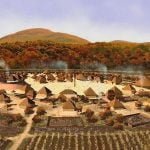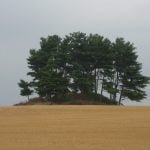
The mural remains, in the United States alone, are of almost incredible number, and of most imposing magnitude. It has been asserted by an accurate western antiquarian should not exaggerate if I were to say that more than five thousand might be found, some of them enclosing more than a hundred acres.” The mounds and tumuli, he remarks, are far more numerous. Professor Rafinesque ascertained the existence of more than five hundred ancient monuments in Kentucky alone, and fourteen hundred in other states, most of which he had personally examined. These remains appear most numerous in the vicinity of the Mississippi and its tributaries, and near the great lakes and the rivers, which flow into them. A striking proof of their immense antiquity is to be found in the fact that the latter stand upon the ancient margin of the lakes, from which, in some immemorial age, their waters are known to have receded.
It is remarkable that these peculiar works of antiquity touch the ocean only in Florida at the southern extremity of the Atlantic coast; and their greater number and magnitude in the south and west seem to fortify the supposition that their founders came originally from Mexico, and were, perhaps, a people identical with the builders of Cholula and Teotihuacan.
The extent of some of these works is extraordinary. In New York, (where at least a hundred of them have been surveyed) in the county of Onondaga, formerly existed the remains of a fortification enclosing more than five hundred acres. Three circular forts, disposed as a triangle, and situated about eight miles distant from each other, served as its outworks. In many of these fortified places, considerable military skill is evinced; angles, bastions, and curtains, being frequently traceable. “Though much defaced by time,” says a traveler, of the entrenchments near Lake Pepin, “every angle was distinguishable, and appeared as regular, and fashioned with as much military skill, as if planned by Vauban himself.”
Some of the most remarkable of these works have been discovered in Georgia. On the banks of the Little River, near Wrightsborough, are found the remnants of “a stupendous conical pyramid, vast tetragon terraces, and a large sunken or excavated area of a cubical form, encompassed with banks of earth, and also the remains of an extensive town.” Other and similar structures occur in the same region. On the Savannah, among other extensive remains, is a conical mound, truncated, fifty feet in height, and eight hundred in circumference at its base. In other portions of the same region are found excavations, and vast quadrangular terraces. Florida abounds in vestiges of a similar nature.
At the west, these remains assume a much more permanent and imposing character. On a branch of the Muskingum River, in Ohio, a series of entrenchments and mounds, two miles in length, and of great solidity of structure, is found to exist. In Licking County, a most extensive range of fortifications, embracing or protecting an extent of several miles, has been traced.

At Circleville, in the same state, were found two extensive earthen enclosures, one an exact circle, and the other a correct square, corresponding precisely to the cardinal points of the compass; and a mound ninety feet in height. In most of these and other similar ruins, stone was used, though to a limited extent. Parallel walls, communicating with the water, sometimes at a distance of several miles, are features common* to many of these structures. Farther west, the extensive use of brick in constructing similar edifices has been ascertained; and an arched sewer, constructed of stone, indicates a knowledge of architecture far superior to that possessed by most semi-civilized nations.
In Missouri, and other regions of the west, the remains of stone buildings have been frequently discovered in one instance, those of a town, regularly laid out in streets and squares. Upon the Missouri and Arkansas Rivers, some of the most extensive fortified works are found. In one of these, on the latter river, are two immense mounds, truncated, each eighty feet high, and one thousand in circumference at the base.
These gigantic mounds are among the most interesting and thickly scattered relics of the vanished races. Many of them are tumuli, or sepulchers of the dead, others were connected with the defensive fortifications, and others, of the grandest and most imposing aspect, were probably huge altars of idolatrous worship.1 In general, these ancient mounds may be distinguished from those of the Indians by their greater size, and still more certainly by the nature of their contents. Some of these latter have already been described. Besides utensils of lead, silver, and copper, the oxydized remains of iron have been found. Mica mirrors of various sizes, with a variety of marine shells, are among the deposits.
The practice of burning the dead appears to have been common. Masses of ashes and charcoal are often found mixed with incinerated bones. In Fairfield County, Ohio, a huge earthenware caldron, placed upon a furnace, was disinterred. It was eighteen feet long by six broad; and contained the skeletons of twelve persons, besides various articles, which had been buried with them. They were in a large mound, fifteen feet below the surface of the earth.
In the great mound at Circleville, an immense number of skeletons were found, all laid with their heads toward the center.
In Illinois, nearly opposite St. Louis, within the circuit of a few miles, are more than an hundred and fifty mounds, some of extraordinary size. One of them, formerly occupied by monks of the Order of La Trappe, is ninety feet in height and nearly half a mile in circumference. It is a remarkable circumstance that the soil of which these huge cones are constructed, must occasionally have been brought from a great distance. The occasional existence of terraces or stages of ascent would, seem to indicate a similarity of origin with the pyramidal structures of Mexico.
Indeed, it is difficult to suppose that the authors of these extensive remains could have had other than a southwestern origin. All are ancient in the extreme; yet probably they were erected by successive races, and the most venerable antiquity seems attached to the forest-covered mounds of the West.
Mr. Bradford, in his interesting Researches into the Origin of the Red Race, (from which many of the foregoing facts have been drawn,) adopts with safety the following conclusions in regard to the ancient occupants of our soil.
- “That they were all of the same origin, branches of the same race and possessed of similar customs and institutions.
- “That they were populous, and occupied a great extent of territory.
- “That they had arrived at a considerable degree of civilization, were associated in large communities, and lived in extensive cities.
- “That they possessed the use of many of the metals, such as lead, copper, gold, and silver, and probably the art of working in them.
- “That they sculptured, in stone, and sometimes used that material in the construction of their edifices.
- “That they had the knowledge of the arch of receding steps; of the art of pottery, producing urns and utensils formed with taste, and constructed upon the principles of chemical composition; and of the art of brick-making.
- “That they worked the salt springs, and manufactured that substance.
- “That they were an agricultural people, living under the influence and protection of regular forms of government.
- “That they possessed a decided system of religion, and a mythology connected with astronomy, which, with its sister science, geometry, was in the hands of the priesthood.
- “That they were skilled in the art of fortification.
- “That the epoch of their original settlement in the United States is of great antiquity;
Lastly, “That the only indications of their origin, to be gathered from the locality of their ruined monuments, point towards Mexico.”
